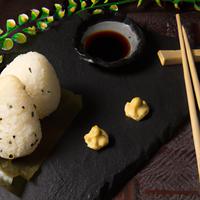
1 serving (200 grams) contains 400 calories, 8.0 grams of protein, 10.0 grams of fat, and 60.0 grams of carbohydrates.

Log this food in SnapCalorie

Nutrition Information
Calories |
470.6 | ||
|---|---|---|---|
% Daily Value* |
|||
| Total Fat | 11.8 g | 15% | |
| Saturated Fat | 2.4 g | 12% | |
| Polyunsaturated Fat | 0 g | ||
| Cholesterol | 11.8 mg | 3% | |
| Sodium | 705.9 mg | 30% | |
| Total Carbohydrates | 70.6 g | 25% | |
| Dietary Fiber | 2.4 g | 8% | |
| Sugars | 2.4 g | ||
| protein | 9.4 g | 18% | |
| Vitamin D | 0 mcg | 0% | |
| Calcium | 23.5 mg | 1% | |
| Iron | 1.8 mg | 10% | |
| Potassium | 176.5 mg | 3% | |
* Percent Daily Values are based on a 2,000 calorie diet. Your daily values may be higher or lower depending on your calorie needs.
Food Attributes
Source of Calories
About Onigiri with tempura
Onigiri with tempura is a delightful fusion of textures and flavors originating from Japanese cuisine. Onigiri, a traditional rice ball often wrapped in nori (seaweed), serves as the base, offering a satisfying source of energy-packed carbohydrates. The tempura component typically consists of lightly battered and deep-fried vegetables or shrimp, adding a crunchy, savory contrast to the soft rice. While onigiri is an inherently simple and wholesome dish, the tempura adds indulgence through its fried preparation, increasing fat and calorie content. Nori provides trace minerals like iodine, while the overall dish can be enriched with fillings such as grilled salmon, pickled plum, or sesame seeds for added nutrients. Moderation is key with this hearty combo, as it balances both the wholesome simplicity of the rice and the richness of tempura, making it a flavorsome yet occasional treat for those enjoying a taste of Japanese comfort food.



